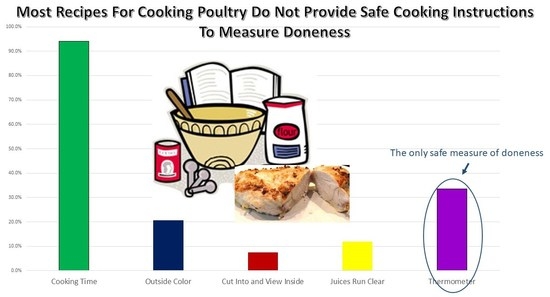Recipes for Determining Doneness in Poultry Do Not Provide Appropriate Information Based on US Government Guidelines
Abstract
:1. Introduction
2. Materials and Methods
Recipe Selection and Analysis
3. Results and Discussion
3.1. Endpoint Temperatures
3.2. Thermometer Placement Information
3.3. General Findings
4. Conclusions
Author Contributions
Funding
Conflicts of Interest
References
- World Health Organization. WHO Estimates of the Global Burden of Foodborne Diseases. 2015. Available online: http://apps.who.int/iris/bitstream/10665/200046/1/WHO_FOS_15.02_eng.pdf?ua=1 (accessed on 5 July 2018).
- Centers for Disease Control and Prevention. CDC Estimates of Foodborne Illness in the United States. 2016. Available online: http://www.cdc.gov/foodborneburden/estimates-overview.html (accessed on 5 July 2018).
- Byrd-Bredbenner, C.; Berning, J.; Martin-Biggers, J.; Quick, V. Food safety in home kitchens: A synthesis of the literature. Int. J. Environ. Res. Public Health 2013, 10, 4060–4085. [Google Scholar] [CrossRef] [PubMed]
- United States Department of Health and Human Services. Healthy People 2020: Food Safety; Office of Disease Prevention and Health Promotion: Washington, DC, USA, 2010.
- U.S. Department of Agriculture Food Safety and Inspection Service. Safe Minimum Internal Temperature Chart. 2015. Available online: https://www.fsis.usda.gov/wps/portal/fsis/topics/food-safety-education/get-answers/food-safety-fact-sheets/safe-food-handling/safe-minimum-internal-temperature-chart/ct_index (accessed on 5 July 2018).
- Patten, E.; Sneed, J.; Nwadike, L.V. Food handling practices and food safety messaging preferences of African American and Latino consumers. J. Hum. Sci. Ext. 2018, 6, 1–17. [Google Scholar]
- Kosa, K.; Cates, S.; Bradley, S.; Godwin, S.; Chambers, E., IV; Ricketts, J.; Chen, F.; Kilonzo-Nthenge, A.; Nahashon, S.; Chambers, D. Food thermometer usage among consumers who cook raw poultry. J. Food Prot. 2014, 77 (Suppl. A), 138. [Google Scholar]
- Maughan, C.; Chambers, E., IV; Godwin, S.; Chambers, D.; Cates, S.; Koppel, K. Food Handling Behaviors Observed in Consumers When Cooking Poultry and Eggs. J. Food Prot. 2016, 79, 970–977. [Google Scholar] [CrossRef] [PubMed]
- Bruhn, C. Chicken preparation in the home: An observational study. Food Prot. Trends 2014, 34, 318–330. [Google Scholar]
- Hicks, D.T. Seafood safety and quality: The consumer’s role. Foods 2016, 5, 71. [Google Scholar] [CrossRef] [PubMed]
- Kosa, K.; Cates, S.; Godwin, S.; Chambers, E., IV. Barriers to using a food thermometer when cooking poultry at home: Results from a national survey. Food Prot. Trends 2017, 37, 116–125. [Google Scholar]
- Kosa, K.; Cates, S.; Bradley, S.; Chambers, E., IV; Godwin, S. Consumer-reported handling of raw poultry products at home: Results from a national survey. J. Food Prot. 2015, 78, 180–186. [Google Scholar] [CrossRef] [PubMed]
- Maughan, C.; Chambers, E., IV; Godwin, S. A procedure for validating the use of photographs as surrogates for samples in sensory measurement of appearance: An example with color of cooked turkey patties. J. Sens. Stud. 2016, 31, 507–513. [Google Scholar] [CrossRef]
- Maughan, C.; Godwin, S.; Chambers, D.; Chambers, E. Recipe Modification Improves Food Safety Practices during Cooking of Poultry. J. Food Prot. 2016, 79, 1436–1439. [Google Scholar] [CrossRef] [PubMed]
- Godwin, S.; Stone, R.; Hallman, W.; Senger-Mersich, A. Identifying gaps in food safety information provided by online companies and consumers’ expectations. J. Acad. Nutr. Diet. 2014, 114, A75. [Google Scholar] [CrossRef]
- Kornelis, M.; de Jonge, J.; Frewer, L.; Dagevos, H. Consumer selection of food-safety information sources. Risk Anal. 2007, 27, 327–335. [Google Scholar] [CrossRef] [PubMed]
- Whatley, K.W.; Doerfert, D.L.; Kistler, M. An examination of the food safety information sources and channels utilized and trusted by residents of Lubbock, Texas. J. Agric. Educ. 2005, 46, 70–81. [Google Scholar] [CrossRef]
- Godwin, S.; Maughan, C.; Chambers, E. Food safety: Recommendations for determining doneness in consumer egg dish recipes and measurement of endpoint temperatures when recipes are followed. Foods 2016, 5, 45. [Google Scholar] [CrossRef] [PubMed]
- Griffith, C.J.; Mathias, K.A.; Price, P.E. The mass media and food hygiene education. Br. Food J. 1994, 96, 16–21. [Google Scholar] [CrossRef]
- McCurdy, S.M.; Takeuchi, M.T.; Edwards, Z.M.; Edlefsen, M.; Dong-Hyun, K.; Mayes, V.E.; Hillers, V.N. Food safety education initiative to increase consumer use of food thermometers in the united states. Br. Food J. 2006, 108, 775–794. [Google Scholar] [CrossRef]
- Levine, K.; Chaifetz, A.; Chapman, B. Evaluating food safety risk messages in popular cookbooks. Br. Food J. 2017, 119, 1116–1129. [Google Scholar] [CrossRef]
- HPBA Publishes Latest Barbecue Usage Study. 2016. Available online: http://www.casualliving.com/article/530762-hpba-publishes-latest-barbecue-usage-study (accessed on 9 March 2017).
- Murray, R.; Glass-Kaastra, S.; Gardhouse, C.; Marshall, B.; Ciampa, N.; Franklin, K.; Hurst, M.; Thomas, M.K.; Nesbitt, A. Canadian consumer food safety practices and knowledge: Foodbook study. J. Food Prot. 2017, 80, 1711–1718. [Google Scholar] [CrossRef] [PubMed]
- Hoey, J. Campylobacter enteritis: It could happen to you! Can. Med. Assoc. J. 1998, 158, 1056–1057. [Google Scholar] [CrossRef]
- U.S. Department of Agriculture Food Safety and Inspection Service. Kitchen Thermometers. 2011. Available online: https://www.fsis.usda.gov/wps/wcm/connect/d8151061-bb50-46db-b87e-a3b9022c0c56/Kitchen_Thermometers.pdf?MOD=AJPERES (accessed on 5 July 2018).
- Kennedy, J.; Gibney, S.; Nolan, A.; McMahon, M.; McDowell, D.; Fanning, S.; Wall, P. Identification of critical points during domestic preparation: An observational study. Br. Food J. 2011, 113, 766–783. [Google Scholar] [CrossRef]
- Allison, A.; Fouladkhah, A. Adoptable interventions, human health, and food safety considerations for reducing sodium content of processed food products. Foods 2018, 7, 16. [Google Scholar] [CrossRef] [PubMed]



© 2018 by the authors. Licensee MDPI, Basel, Switzerland. This article is an open access article distributed under the terms and conditions of the Creative Commons Attribution (CC BY) license (http://creativecommons.org/licenses/by/4.0/).
Share and Cite
Chambers, E., IV; Godwin, S.; Terry, T. Recipes for Determining Doneness in Poultry Do Not Provide Appropriate Information Based on US Government Guidelines. Foods 2018, 7, 126. https://doi.org/10.3390/foods7080126
Chambers E IV, Godwin S, Terry T. Recipes for Determining Doneness in Poultry Do Not Provide Appropriate Information Based on US Government Guidelines. Foods. 2018; 7(8):126. https://doi.org/10.3390/foods7080126
Chicago/Turabian StyleChambers, Edgar, IV, Sandria Godwin, and Taylor Terry. 2018. "Recipes for Determining Doneness in Poultry Do Not Provide Appropriate Information Based on US Government Guidelines" Foods 7, no. 8: 126. https://doi.org/10.3390/foods7080126






